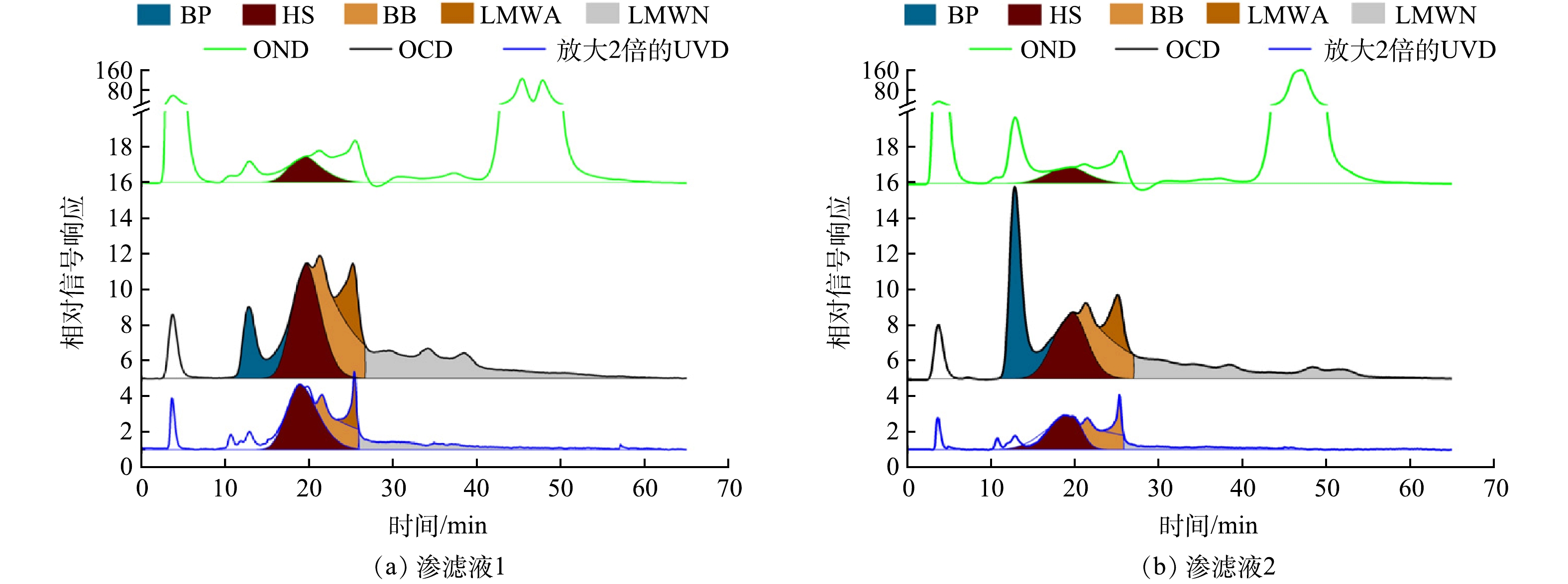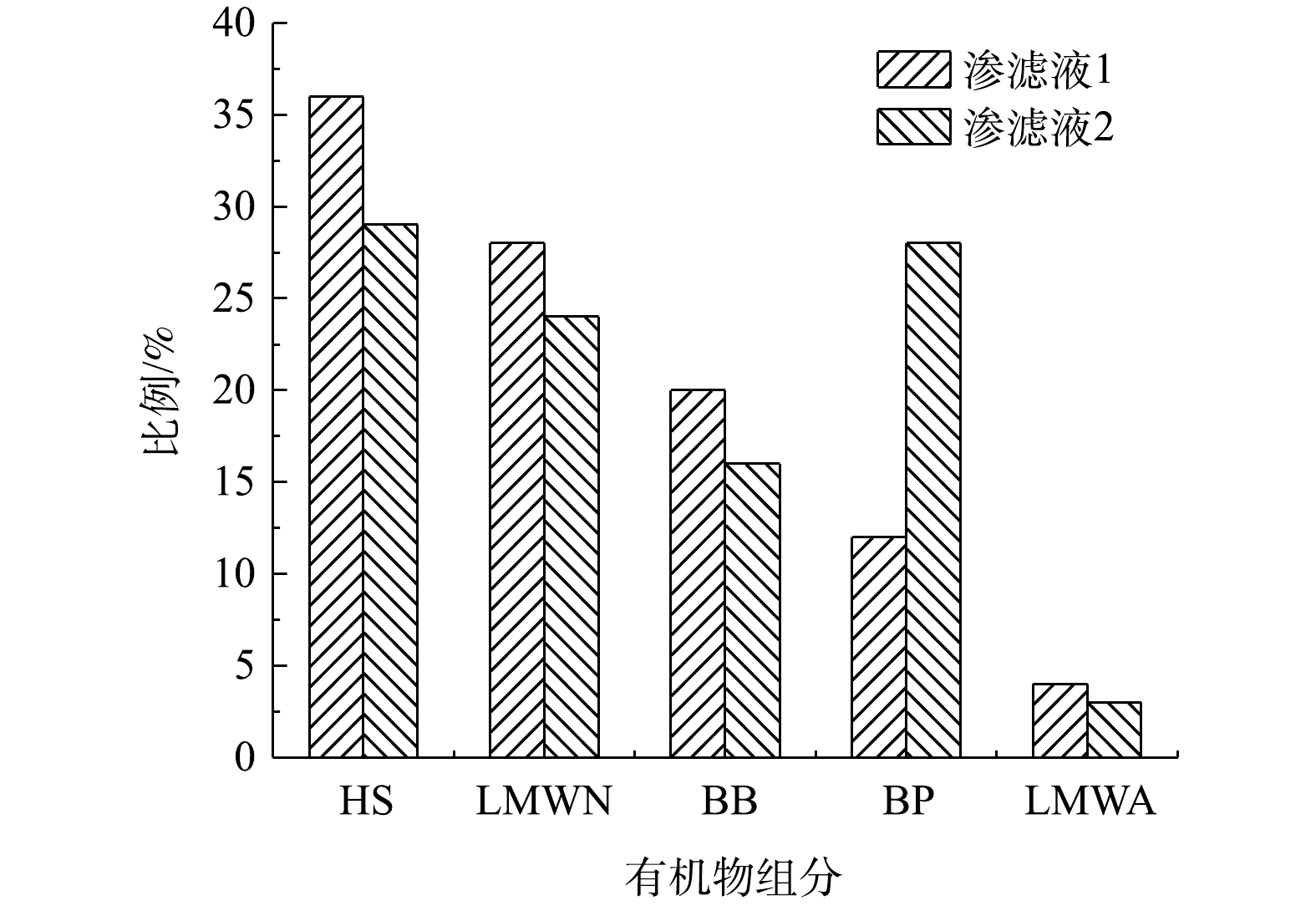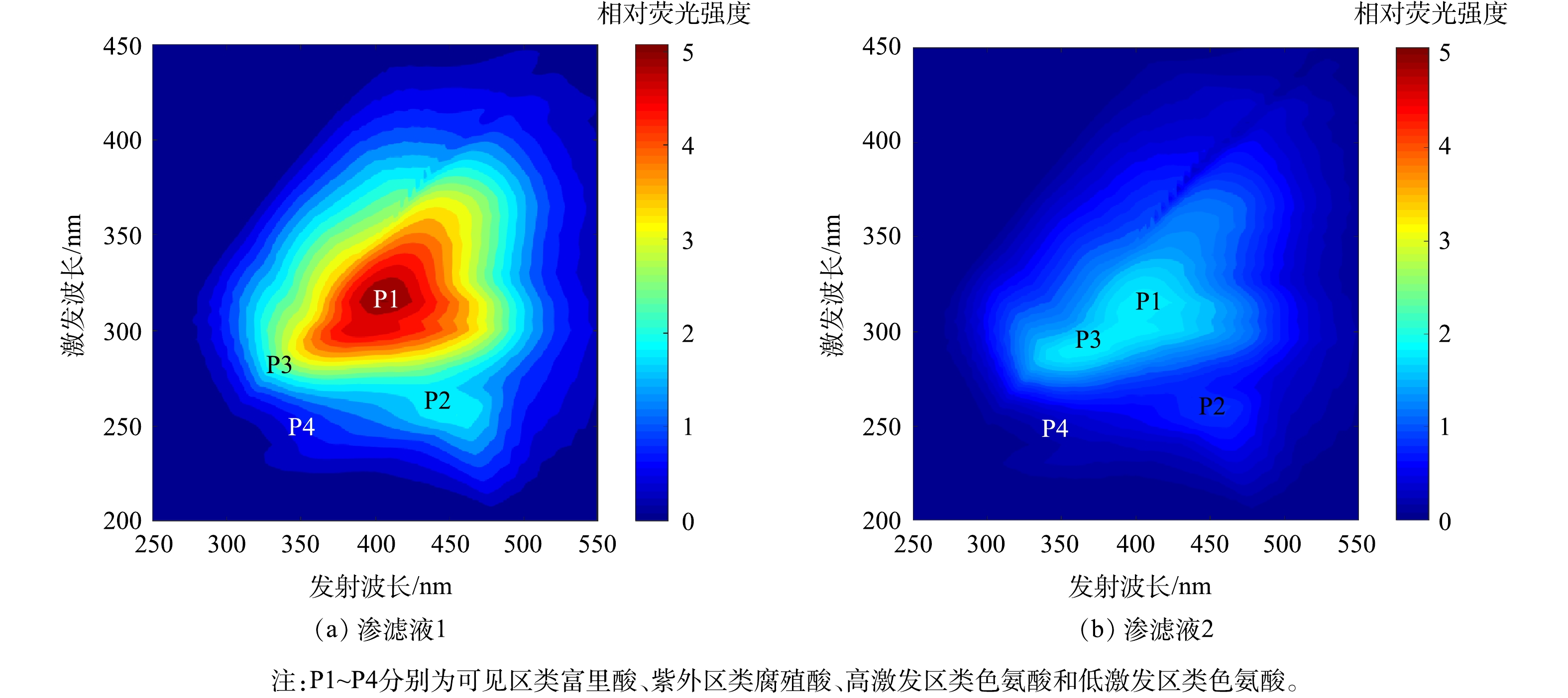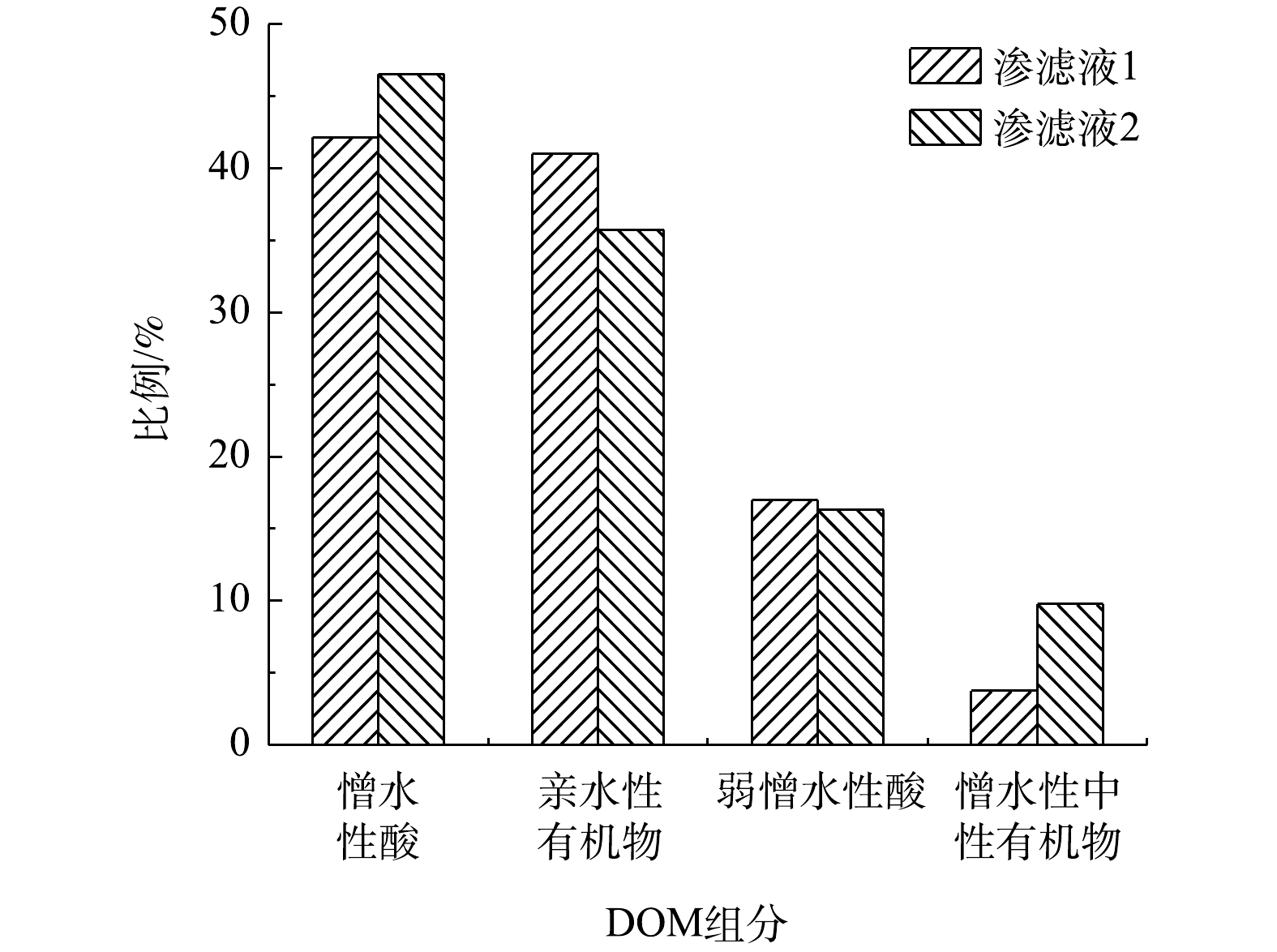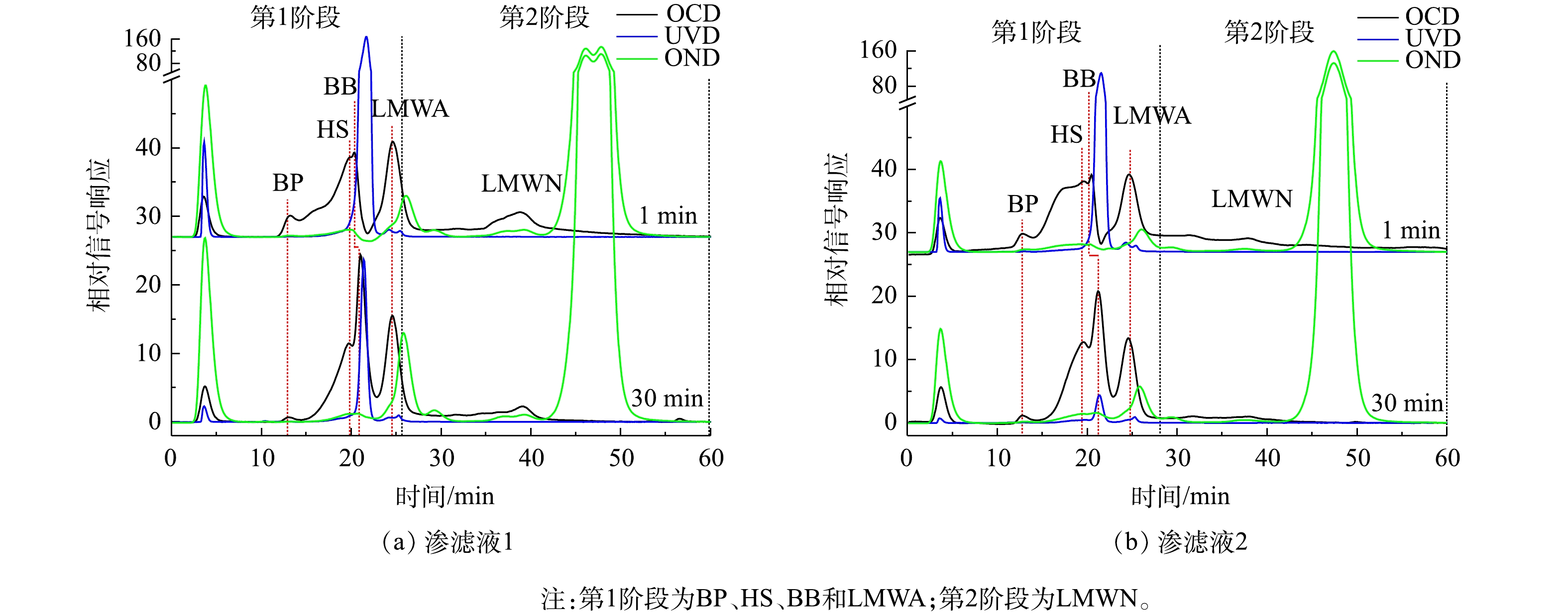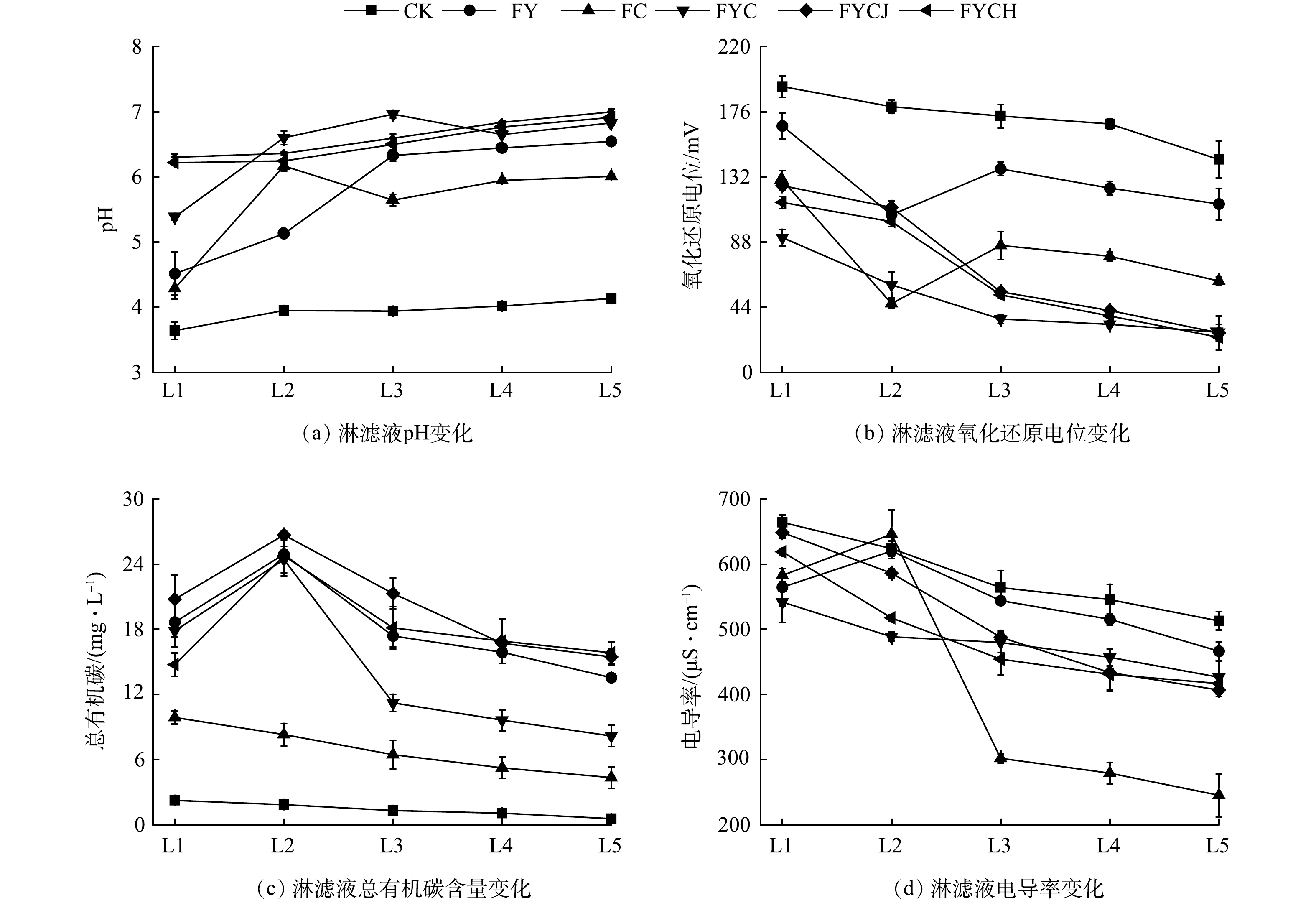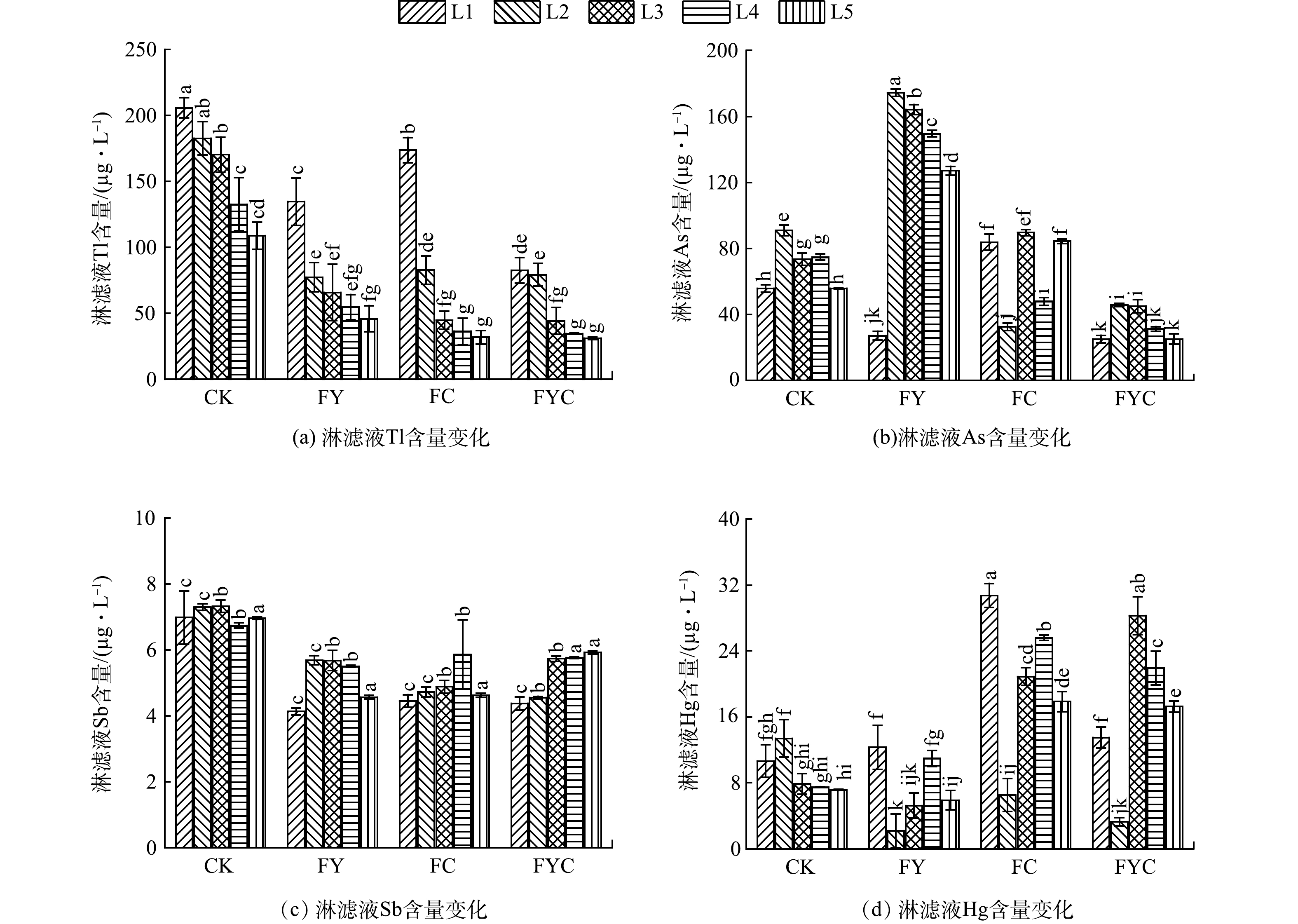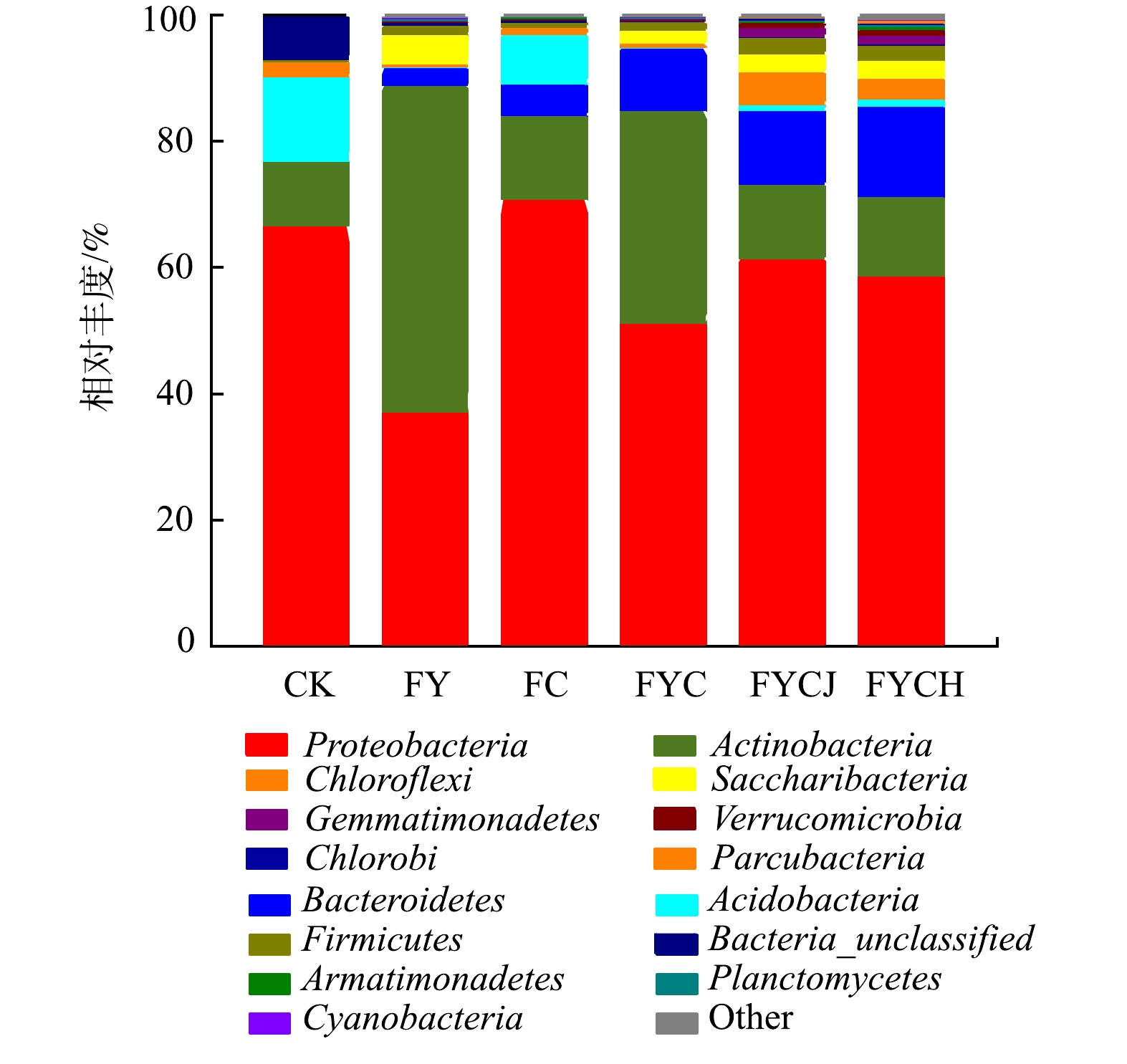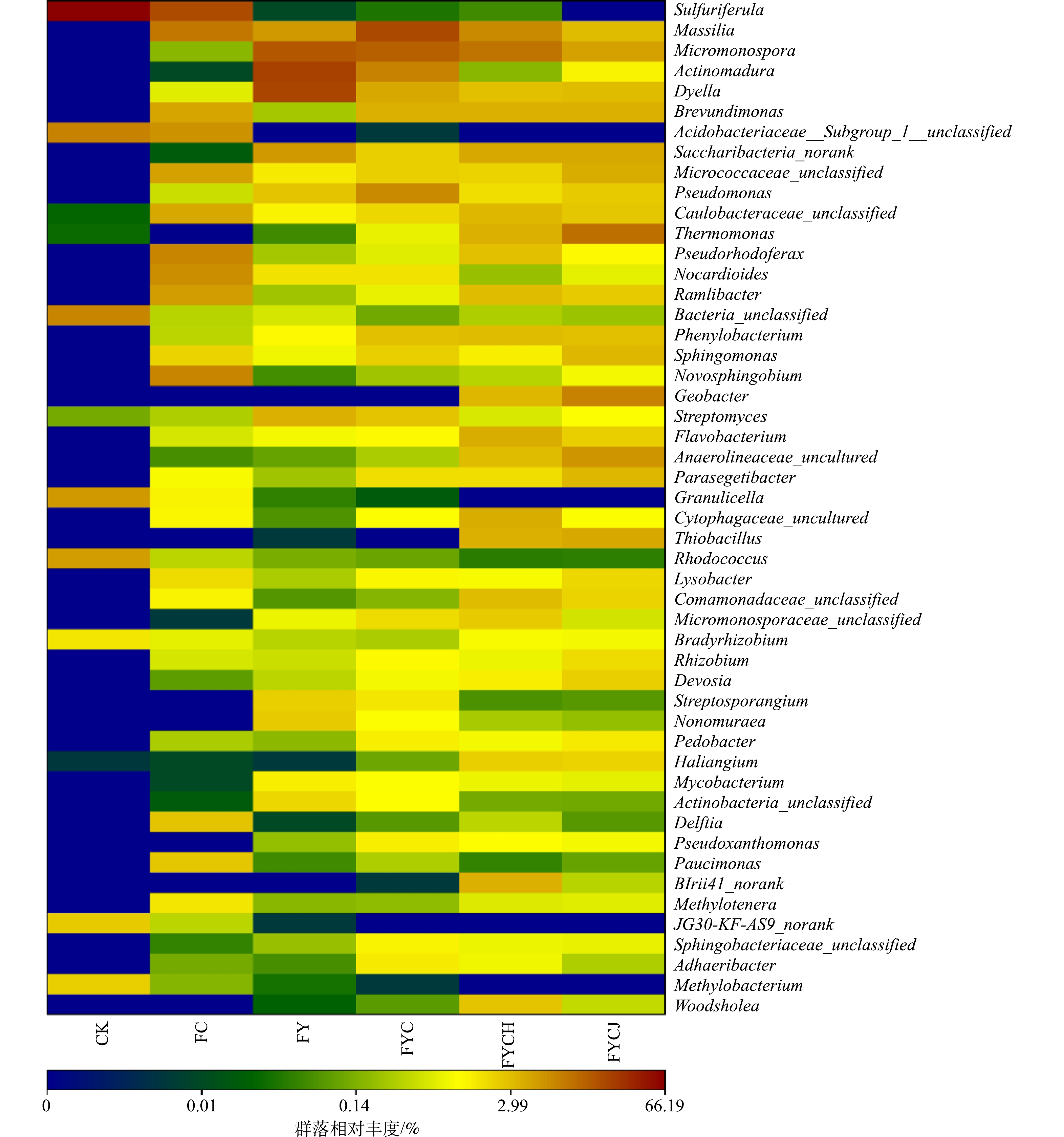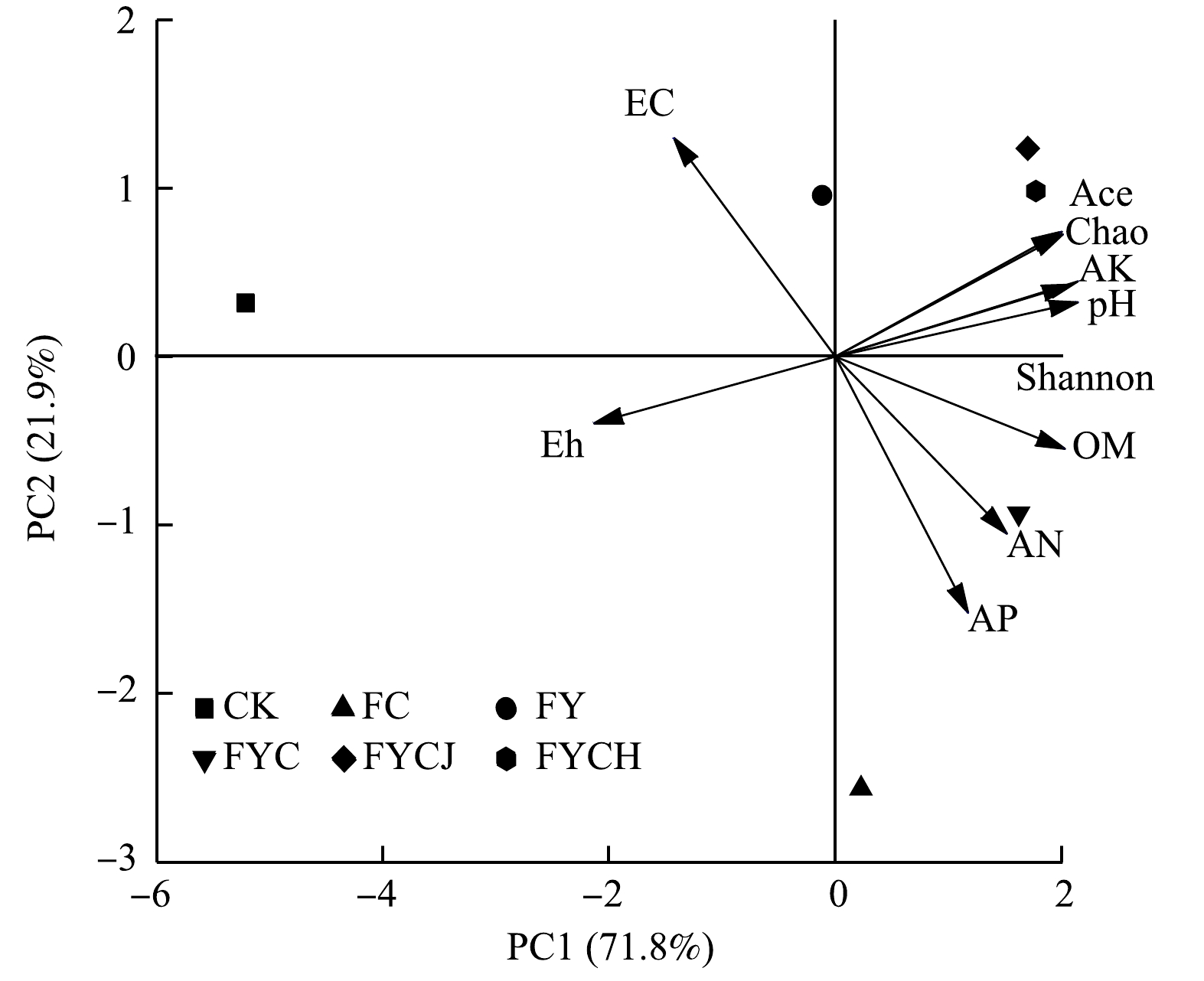-
贵州省黔西南州兴仁市滥木厂汞铊矿区是一个独特的Hg、As、Sb及Tl的天然富集区,同时也是多金属污染最严重、最典型的矿区[1-2]。该地区存在较高的金属地质背景值,Hg、As、Sb和Tl作为该矿区的典型重金属,广泛存在于土壤、河流、沉积物以及农作物中[3-7]。在常年风化和淋溶环境下,长期堆存的汞铊矿废弃物被持续氧化和冲刷,导致废弃物的Hg、As、Sb、Tl等重金属释放迁移至周边的水体和土壤中,对生态环境污染和人体健康带来巨大风险[8-10]。目前,矿山废弃物的常用治理方法包括物理法、化学法和生物法。其中,生物修复策略基于植物与微生物结合,通过固化、积累和稳定污染物达到环境修复的效果,该法因其环境友好、成本低廉且可长期自维持的优势而被广泛应用[11-15]。然而,矿山废弃物因其特殊的物理、化学和生物特性限制了植物与微生物的生长,同时也阻碍了废弃物的资源化利用,因此对矿山废弃物进行改良修复十分必要[16-17]。鱼粪作为水产养殖废弃物,不仅富含氮、磷、钾、碳等营养元素及多种保水成份和生物活性物质,能对矿山生境的改善起到一定作用;赤泥作为铝工业废弃物,因富含铁铝及碱性物质可对酸性环境中多种重金属具有一定钝化作用,能够降低重金属的溶出度和有效性[18-21]。因此,利用鱼粪与赤泥可有效地改良矿山废弃物的生境条件,为植物生长提供有利条件。黑麦草(Lolium perenne L.)是一种常见的草本植物,具有生长快、产量高、耐刈割等特点,对重金属具有较强的抗性和富集能力;巨菌草(Pennisetum giganteum)因其生物量大、适应性强、重金属富集能力,已被用于土壤Pb、Cd等重金属的植物修复[22-26]。基质改良与植物联合修复是改善矿业固体废弃物堆场恶劣生境及控制重金属污染物释放的有效途径。目前,利用有机改良剂(鸡粪、牛粪等)以及无机改良剂(碳酸盐岩、石灰等)联合植物(黑麦草、三叶草等)对重金属污染场地进行修复已有较多报道[27-31],但关于利用鱼粪和赤泥作为改良剂并联合黑麦草及巨菌草对富含多种重金属的汞铊矿废弃物进行修复的研究鲜有报道。因此,探明有机和无机改良剂与植物联合修复对汞铊矿废弃物中重金属淋溶释放的原位控制及修复后的微生物群落结构特征对矿山废弃物堆场生态修复具有重要指导意义。
本研究采用富铁铝的铝业废弃物(赤泥)与富含有机质的渔业废弃物(鱼粪)作为改良剂,结合两种典型先锋速生植物(巨菌草和黑麦草)分别探究单一改良剂、混合改良剂及改良剂与植物联合修复对汞铊矿废弃物中典型重金属淋溶释放的原位控制效果;在此基础上分析改良剂和植物修复对汞铊矿废弃物理化性质及微生物群落结构特征的影响。相关研究结果可为大型多金属矿山废渣堆场的重金属污染释放的原位控制与无土快速生态修复提供理论依据。
-
汞铊矿废弃物采自中国贵州省黔西南兴仁市滥木厂(25°18′-25°47′N,104°54′-105°34′E)汞铊矿矿区。现场采样按五点取样法在约10 000 m2的汞铊矿废弃物堆场现场采集样品,样品采集完成混匀后带回,去除样品中所含杂物,置于牛皮纸上自然风干,研磨过2 mm筛混匀后备用。鱼粪采集自贵州省黔西南兴义市某水产发展有限公司,赤泥采集自贵州省黔东南麻江县某铝厂赤泥堆场。现场采集后带回的鱼粪和赤泥分别置于牛皮纸上,在室内剔除杂物、自然风干,研磨后过2 mm筛,充分混匀备用。汞铊矿废弃物、鱼粪和赤泥的理化性质见表1。黑麦草种子和巨菌草购买自河南省世纪天缘生态科技有限公司。混合改良剂与汞铊矿废弃物混匀后分别种植黑麦草和巨菌草并进行淋滤实验。
-
为考察不同改良剂在单一及复合使用条件下联合不同植物对汞铊矿废弃物的污染释放的原位控制作用,开展了为期150 d的淋滤(淋滤柱为直径110 mm、高400 mm的圆柱形PVC管)实验。共设置6个处理组(见表2),包括一个对照组和5个处理组,每个组设置3个平行,共18根淋滤柱。淋滤量根据采样地年降雨量(1 250~1 400 mm)与淋滤柱横截面积确定为1 000 mL,根据前期预实验确定鱼粪添加量为5%(质量百分比)、赤泥添加量为1%(质量百分比)。实验时间确定为3~7月,该时间段符合黑麦草与巨菌草的生长周期和气温要求,且淋滤量能够满足2种植物的生长。实验淋滤实验后为防止淋滤柱间产生边际效应,柱与柱之间间隔10 cm,完全随机摆放,且不定期随机更换淋滤柱位置。淋滤柱实验平衡30 d后收集第一次淋滤液(L1),后期每隔30 d收集一次淋滤液,共收集5个批次的淋滤液(L1、L2、L3、L4和L5)。
淋滤实验结束后,去除淋滤柱样品中植物根系及其他杂物,充分混匀样品后按四分法采集,所得各组样品分成2份,1份置于-80 ℃冰箱中保存,用于微生物群测序分析;另1份放在室内通风处自然风干后研磨、过筛,用于理化特性和养分特性的测定。
-
汞铊矿废弃物样品及淋滤液的基本理化性质和养分含量按鲁如坤编写的《土壤农业化学分析方法》的要求进行测定[32]:利用pH计(PHSJ-3F)、电导率仪(DDS-11 A及氧化还原电位测定仪(ORP-422)分别测定pH、电导率(EC)和氧化还原电位(Eh);速效钾采用1 mol·L−1乙酸铵浸提,再用原子吸收光谱仪(TAS-990A)测定;碱解氮采用碱解扩散法测定;有效磷采用0.5 mol/L NaHCO3溶液浸提-钼锑抗比色法测定;OM采用水合热重铬酸钾氧化比色法测定。汞铊矿废弃物和淋滤液样品的Hg、As、Sb利用原子荧光光谱仪(AFS-8510)测定(HJ 694-2014);Tl利用原子吸收光谱仪(TAS-990)测定(HJ 748-2015)。
-
使用HiPure Soil NDA Kit试剂盒(美国OMEGA公司)提取实验样品中细菌总的 DNA。扩增区域为16S rRNA 基因的V3-V4区,引物为338F: 5’-ACTCCTACGGGAGGCAGCAG-3’ 和806R: 5’-GGACTACHVGGGTWTCTAAT-3’。利用1%琼脂糖凝胶电泳检测所提取的基因组DNA,然后进行PCR扩增(PCR仪,ABI GeneAmp® 9700型),利用AxyprepDNA凝胶回收试剂盒(美国AXYGEN公司)切胶回收PCR产物,Tris_HCl洗脱,2%琼脂糖电泳检测。参照电泳初步定量结果,将PCR产物用QuantiFluorTM-ST蓝色荧光定量系统(美国,Promega公司)进行定量检测。构建Illumina PE 250文库,通过 Illumina公司的NovaSeq PE250平台进行测序。
-
利用Excel 2019和IBM SPSS Statistics 19.0软件进行实验数据处理和统计分析,Origin 2017用于图形的生成。
-
由表3可知赤泥与鱼粪与植物联合修复可显著改善汞铊矿废弃物的理化性质(P<0.05),并显著提高汞铊矿废弃物的养分含量。经150 d淋滤实验,各处理组废弃物中pH值均显著升高(P<0.05),由对照组(CK)的强酸性升至接近中性,其中混合改良并种植巨菌草组pH最高;Eh值与对照组相比降幅范围为51.08%~90.34%,均显著降低(P<0.05);EC值相较于CK的272.67 μS·cm−1降至128.67~223.00 μS·cm−1。养分含量方面,各处理组OM(OM)、有效磷(AP)、碱解氮(AN)及速效钾 (AK) 的含量相较于CK组均有显著增加。其中鱼粪的添加对提高汞铊矿废弃物中OM、AP和AN含量效果最好,分别达到3.14 g·kg−1、6.96 mg·kg−1和75.13 mg·kg−1;赤泥的添加对提高汞铊矿废弃物中AK含量效果最好,达到227.78 mg·kg−1。综上,赤泥和鱼粪混合改良可显著改善汞铊矿废弃物理化特性及养分条件,为植物的生长提供有利条件,而混合改良并种植巨菌草则进一步改善了废弃物理化性质。
-
由图1可知,改良剂耦合植物修复可显著改善汞铊矿废弃物淋滤液的理化性质(P<0.05)。赤泥组(FC)、鱼粪组(FY)及混合改良组(FYC)对淋滤液理化性质均有明显改善,种植巨菌草与黑麦草能在改良的基础上进一步提高淋滤液的pH值和总有机(TOC)浓度,降低淋滤液Eh和EC值。各批次淋滤pH呈逐步上升的趋势,巨菌草组(FYCJ))和黑麦草组(FYCH)淋滤液pH值分别达到6.99和6.91。各处理组汞铊矿废弃物淋滤液Eh明显低于对照组,除第2批次淋滤液外,在各批次淋滤液中呈逐渐降低的趋势,巨菌草组及黑麦草组Eh降幅为52.85%~81.21%。巨菌草组及黑麦草组淋滤液中TOC质量浓度相较于CK组提升6.54~27.89倍,赤泥组淋滤液TOC质量浓度相对较低。除L2批次的FC组外,各处理淋滤液EC均低于CK,值得注意的是,L3~L5批次的赤泥组EC相较于CK及其他处理组均有大幅降低,降幅可达12.25%~52.18%。综上,鱼粪和赤泥混合改良并种植黑麦草和巨菌草可显著改善汞铊矿废弃物淋滤液的理化性质,混合改良并种植巨菌草后对汞铊矿废弃物理化性质的改善效果最佳。
-
1)改良剂对汞铊矿废弃物重金属淋溶释放的影响。由图2可知,改良剂的加入对汞铊矿废弃物淋溶释放有显著的影响(P<0.05),鱼粪组(FY)各批次淋滤液中的Tl和Sb质量浓度可降至对照组(CK)的18.29%~61.31%,Tl、Sb的质量浓度最低值分别为45.89 µg·L−1和4.14 µg·L−1;As的质量浓度除L1批次淋滤液外均有增加;而Hg的质量分数随时间推移并无显著趋势,呈上升下降交替出现的特点。赤泥改良组(FC)的各批次淋滤液中Tl和Sb的溶出量相较于CK得到有效的抑制,L5批次淋滤液中TI和Sb最低质量浓度分别降至31.92 µg·L−1和4.6 µg·L−1。赤泥组淋滤液中As的质量浓度无显著变化趋势,而Hg的质量浓度相较于CK呈显著促进释放的趋势(P<0.05)。混合改良组(FYC)对As和Tl的释放有显著的抑制效果(P<0.05),且低于其余3组。As的质量浓度下降至对照组的38.71%~58.34%。混合改良组中Sb的质量浓度较CK虽然降低,但对比鱼粪组、赤泥组发现并未提升Sb的控制效果。对于重金属Hg而言,除L2批次淋滤液较CK和FY组有明显降低外,其余批次淋滤液并无显著抑制效果,反而促进Hg的释放。改良剂的加入可有效控制汞铊矿废弃物中Hg、As、Sb、Tl的淋溶释放,在150 d淋滤实验后所产淋滤液Hg、As含量均符合《污水综合排放标准》要求。综上,鱼粪和赤泥混合改良对汞铊矿废弃物重金属淋溶释放的控制效果最佳。
2)改良剂与植物联合修复对汞铊矿废弃物重金属淋溶释放的影响。由图3可知,混合改良后分别种植巨菌草和黑麦草对汞铊矿废弃物中重金属淋溶释放的影响。混合改良并分别种植巨菌草(FYCJ)和黑麦草组(FYCH)淋滤液中的As、Tl和Sb的质量浓度较对照组(CK)有显著的降低(P<0.05),巨菌草组各批次淋滤液中3种重金属下降率均超过30%,而As、Tl和Sb最低质量浓度均出现在L5批次淋滤液,分别为24.20、52.10、3.11 µg·L−1;黑麦草组各批次淋滤液中3种重金属下降率均超过20%,As、Tl和Sb最低质量浓度均出现在第五批次淋滤液(L5),分别为26.78、47.48、3.07 µg·L−1。值得注意的是,混合改良并种植巨菌草、黑麦草并未提升As、Tl的控制效果;Sb的质量浓度对比混合改良组(FYC)在L2~L5批次淋滤液均有显著下降,而Hg的质量分数相较于CK均有所上升,对比混合改良组除第一、二批次外均有提升,说明巨菌草和黑麦草种植能有效抑制汞铊矿废弃物中Sb的淋溶释放,而在一定程度上促进Hg的淋溶释放。但150 d淋滤实验后所产淋滤液Hg、As含量均符合《污水综合排放标准》要求。
-
表4中列出了改良剂耦合植物修复后汞铊矿废弃物中细菌群落丰富度和多样性指数差异。根据Chao1指数和ACE指数,改良剂耦合植物修复处理有利于改善汞铊矿废弃物中细菌群落丰富度和多样性指数,其中黑麦草组(FYCH)的细菌群落丰富度最高,Chao1和ACE指数分别为对照组的18.45倍和18.74倍。
由图4可知,改良剂耦合植物修复对汞铊矿废弃物在门水平下细菌群落丰度的影响。变形菌门(Proteobacteria)和放线菌门(Actinobacteria)具有较高的相对丰度,除赤泥组(FC)外,不同处理组的变形菌门(Proteobacteria)相对丰度较对照组均有降低,鱼粪组降幅最大(达到44.42%)。不同处理中拟杆菌门(Bacteroidetes)相对丰度明显增加,其中黑麦草组增幅最大(达到14.30%)。此外,与对照组相比,处理后汞铊矿废弃物中绿弯菌门(Chloroflexi)、拟杆菌门(Bacteroidetes)、蓝细菌门(Cyanobacteria)的相对丰度均有不同程度的增加。
改良剂耦合植物修复后汞铊矿废弃物在属水平下的物种丰度聚类热图(图5)显示了在不同处理条件下汞铊矿废弃物样品中丰富度前50的细菌属。结果表明,对照组(CK)与巨菌草组(FYCJ)的细菌群落差异最为明显,CK与赤泥组(FY)的细菌群落差异最小。对照组中相对丰度较高的菌属主要是硫氧化菌属(Sulfuriferula),其相对丰度为66.19%,各处理组中相对丰度较高的菌属则主要是单胞菌属(Micro-monospora)和马赛菌属(Massilia);而颗粒杆菌属(Granulicella)、红球菌属(Rhodococcus)的相对丰度降低,厌氧绳菌属(Anaerolineaceae_uncultured)、铜绿假单胞菌属(Pseudomonas)和鞘氨醇单胞菌属(Sphingomonas)的相对丰度是增加的。
-
本研究结果表明,鱼粪和赤泥作为改良剂可有效地改善汞铊矿废弃物的理化性质,且有机和无机混合改良的改善效果最佳,改良剂的添加可在不需要土壤覆盖下为汞铊矿废弃物堆场后续的植被恢复过程中大量种植的各类植物的生长提供了有利的生境条件。由表1可知,由于鱼粪和赤泥偏中性和碱性,两者的添加有效的调节了汞铊矿废弃物的pH。改良剂的添加,可使环境介质(如土壤及矿山废弃物)pH升高的同时,环境介质中的重金属可形成重金属的氢氧化物、碳酸盐结合态沉淀或共沉淀等, 从而降低环境介质中重金属的移动性和生物有效性[33]而大大减轻重金属对后续植物和微生物的危害与周边的环境污染。鱼粪富含的OM、AP和AN(表1)与赤泥富含的铁铝混合添加于汞铊矿废弃物后可较好地实现汞铊矿废弃物理化性质的改善并增加环境中养分物质的含量(表3),同时有效地改善了汞铊矿废弃物淋滤液的理化性质,植生环境的改善也有利于后续种植的巨菌草或黑麦草,并可进一步改善汞铊矿废弃物及淋滤液理化性质(图1)。因此,鱼粪和赤泥混合改良并种植巨菌草后对汞铊矿废弃物和淋滤液的理化性质改善效果最佳。
实验结果表明,鱼粪和赤泥混合改良不仅具有显著改善汞铊矿废弃物生境的优良作用,还能显著抑制汞铊矿废弃物中Tl、Sb和As的淋溶释放,但一定程度上促进了Hg的淋溶。进一步的分析表明,鱼粪和赤泥混合改良所引入的大量OM、铁铝氧化物是Tl、Sb和As重要的吸附剂,相关组分通过吸附作用和化学沉淀作用控制着汞铊矿废弃物中Tl、Sb和As在环境中的迁移释放行为[33-35]。同时,赤泥中富含的铁氧化物和铝氧化物由于颗粒细小,表面积和孔隙体积较大,由此增加的表面活性位点也可为环境中的重金属离子提供更多的吸附位点,从而使得环境中的重金属更易与铁、铝氧化物结合而被固定[36-39]。此外,具有强碱性物质的赤泥的添加还显著改善了汞铊矿废弃物的酸性(表3),在pH接近中性时,赤泥中所含的碳酸盐可沉淀汞铊矿废弃物中的重金属离子,使得汞铊矿废弃物淋滤液中As、Sb和Tl的含量减少[40]。鱼粪的添加可使大量OM进入汞铊矿废弃物中(表3),其中所含的OM可与汞铊矿废弃物中的Tl、Sb和As发生络合或螯合作用,进而减少汞铊矿废弃物中Tl、Sb和As淋溶释放。有研究表明,动物粪便的添加可提供大量的羧基,羧基的质子化可结合废弃物中的Tl而降低其释放迁移能力[41-43]。本研究中汞铊矿废弃物混合改良显著提升了废弃物的pH和OM含量,且淋滤液中Tl、Sb和As含量较CK组显著降低,由此使得赤泥与鱼粪混合改良后能够有效控制汞铊矿废弃物中Tl、As和Sb的淋溶释放。但需要注意的是,鱼粪和赤泥混合改良在一定程度上促进了汞铊矿废弃物中Hg的释放,其原因可能是加入赤泥使汞铊矿废弃物pH上升影响了鱼粪中的OM对Hg的固定,减少Hg的吸附量,从而促进Hg释放,这与许多研究结果一致[44-46]。混合改良并种植黑麦草和巨菌草进一步的减少了Sb的淋溶释放,巨菌草组对Hg淋溶释放的控制较好,但未进一步的加强对Tl、As和Hg的固化作用。这可能是因为黑麦草和巨菌草吸收了部分有效态的Sb;As的植物吸收量较低可能是因为植物根际或植物体内的大量磷酸根与砷酸根存在竞争吸收,导致As吸收量降低;鱼粪在中和废弃物酸性时产生的磷酸根可能抑制Tl的迁移释放,导致植物对Tl吸收量较低;巨菌草因其较大的生物量,因此相对黑麦草可能吸收更多的Hg[25,28,47-49]。综上所述,鱼粪和赤泥混合改良并种植巨菌草对汞铊矿废弃物和淋滤液的理化性质、养分含量和淋滤液重金属含量的改善效果最佳,该方案可用于汞铊矿废弃物污染释放原位控制的原位控制与无土快速生态修复。
与对照相比,赤泥与鱼粪耦合植物修复后矿山废弃物中微生物群落丰富度和多样性增加。汞铊矿废弃物的强酸性会抑制微生物活动和细菌生长,破坏细菌细胞膜的通透性和稳定性,但使用富含微生物的鱼粪并加上具有优良中和作用的赤泥进行改良会显著的提高汞铊矿废弃物中的外源微生物的丰富度和多样性,并改善土壤理化性质情况,在短期内增加微生物多样性和生物量[50-53]。由图6对淋滤实验后汞铊矿废弃物门水平下的细菌群落组成及其环境因子进行主成分分析可知,对照组中汞铊矿废弃物的细菌群落组成受EC和Eh的影响较大,各处理组受pH、AN、AK、OM、AP含量的影响较大。汞铊矿废弃物pH、OM和AK含量与微生物群落呈极显著正相关(P<0.01)。土壤微生物是维持土壤功能的关键,如C、N循环和OM分解代谢,微生物群落受土壤pH、养分和有机碳含量等因素的影响[54-55]。OM是土壤中重要的基础指标,鱼粪中含有丰富的OM,使得汞铊矿废弃物肥力得到大幅度提高,这是FY组OM含量增加的重要原因;实验期内黑麦草和巨菌草凋落物较少,后期没有外加营养物质进行营养元素的补充,加上植物由于自身生长需要不断消耗汞铊矿废弃物肥力及其氧化还原作用[56],导致实验后期汞铊矿废弃物的OM含量有所降低。OM的积累与分解状况对于氮素和磷素的供应会造成影响,因此碱解氮和速效磷的变化与OM具有一定的相似性。废弃物中营养状况的改善不仅促进其土壤化过程,而且加速其中微生物的活动,最终有利于矿山废弃物堆场生境的持续改善和生态植被的恢复。
赤泥与鱼粪联合植物修复后汞铊矿废弃物中蓝细菌门(Cyanobacteria)相对丰度有所增加,先前的研究发现接种蓝细菌可以增加土壤有机碳并防止土壤侵蚀以改善土壤质量,又由于蓝细菌具有固氮、促进植物生长激素和抗氧化酶的产生等显著特征,使其在盐渍化土壤修复和改良方面具有广阔的前景[57]。另外,植物的生命活动通常会促进微生物群落通过创造有吸引力的环境(如根系分泌物、脱落的根系细胞和粘液)来促进发育[58]。微生物参与生物降解、固氮和矿物风化,这可以促进植物的生长。植物和微生物相互作用有利于植物的建立和微生物群落物种的改善,从而显著改善强酸性矿山废弃物堆场的生境条件,保障生物生长与促进生态修复的作用,最终促进生态系统的恢复。
-
1)鱼粪和赤泥混合改良并种植巨菌草(FYCJ)对汞铊矿废弃物中重金属的淋溶释放控制和微生物群落重建综合效果最佳。
2)鱼粪和赤泥混合改良并种植巨菌草(FYCJ)组显著改善了汞铊矿废弃物的理化性质和养分条件,使废弃物pH接近中性,废弃物中AN、AK、OM、AP养分含量显著上升。植生条件显著改善。同时,处理后的该组淋滤液中As、Tl和Sb含量较对照组显著下降(P<0.05),从而降低了As、Tl和Sb淋溶释放进入生态环境的风险。该处理中淋滤液重金属含量和理化性质改善效果最佳,提升淋滤液pH至中性,降低淋滤液的Eh、EC和TOC含量,淋滤液Hg、As含量及pH均符合《污水综合排放标准》要求。
3)汞铊矿废弃物中微生物群落的丰富度和多样性得到显著改善,其中蓝菌门(Cyanobacteria)、拟杆菌门(Bacteroidetes)等功能菌群的相对丰度明显升高。pH、OM和速效钾含量与微生物群落丰富度和多样性呈极显著正相关关系(P<0.01),因此矿山开采废弃物微生物群落重建可从改善pH、OM及AK含量3个方向开展。
改良剂与植物联合修复对汞铊矿废弃物重金属淋溶释放行为及微生物群落结构的影响
Effect of combined remediation with the conditioners and plants on heavy metal leaching release behavior and microbial community structure of mercury-thallium mine wastes
-
摘要: 为探究改良剂赤泥(富铁铝的工业废弃物)与鱼粪(富氮磷的有机质)作为改良剂结合2种典型先锋速生植物(巨菌草和黑麦草)对汞铊矿废弃物中典型重金属(Hg、As、Sb、Tl等)淋溶释放的原位控制效果,通过150 d淋滤实验,考察了单一改良剂、混合改良剂及改良剂联合植物对汞铊矿废弃物和淋滤液理化特征、重金属淋溶释放规律及微生物群落结构的影响。结果表明,添加鱼粪和赤泥结合植物种植能显著抑制汞铊矿废弃物中As、Tl和Sb的释放,同时显著促进废弃物中Hg的溶出(P<0.05)。随着淋溶时间的延长,5个批次淋滤液中As、Tl和Sb的质量浓度分别降至对照组的21.28%~56.56%、33.21%~63.15%、32.23%~56.62%。经处理后汞铊矿废弃物中养分有所提高,相较于对照组,各处理组废弃物pH由3.87升至5.56~6.78,速效钾(AK)含量是对照组的5.60~8.75倍,有机质(OM)由对照组的0.64 g·kg−1增至2.50~3.14 g·kg−1。同时,改良剂与植物联合修复改善了汞铊矿废弃物微生物群落丰富度和多样性,其中以黑麦草组的细菌群落丰富度最高。综合考虑重金属淋溶释放控制和微生物群落结构改善,选择鱼粪和赤泥混合改良并种植巨菌草对汞铊矿废弃物的修复效果最佳,以上研究结果可为汞铊矿废弃物中重金属释放的原位控制与无土快速生态修复提供技术支持。Abstract: To investigate the in-situ control effects of typical heavy metal leaching release from mercury-thallium mine wastes by combining the conditioners of the modified red mud (Iron and Aluminum-rich industrial waste) and fish manure (Nitrogen and Phosphorus-rich organic matter) with two typical pioneer fast-growing plants (giant fungus grass and ryegrass), the 150d-leaching experiments were conducted to study the effects of single conditioner, mixed conditioner and modified conditioner-plant cultivation on the physicochemical characteristics, heavy metal leaching release and microbial community structure of mercury thallium mine waste and leachate. The results showed that the addition of fish manure and red mud combined with plant cultivation significantly inhibited the release of As, Tl and Sb from the mercury thallium mine waste, and significantly promoted Hg leaching from the waste (P<0.05). With the extension of the leaching time, the mass concentrations of As, Tl and Sb in the leachate of 5 batch experiments decreased to 21.28%~56.56%, 33.21%~63.15% and 32.23%~56.62% of the control group, respectively. The nutrients of the treated wastes increased. Compared with the control group, the pH of the treated wastes increased from 3.87 to 5.56~6.78, the content of fast-acting potassium was 5.60~8.75 times higher than that of the control group, and the organic matter increased from 0.64 g·kg−1 in the control group to 2.50~3.14 g·kg−1. At the same time, the conditioner-plant combined remediation improved the microbial community richness and diversity of mercury thallium mine waste, with the highest bacterial community richness in the ryegrass group. Considering the control of leaching and release of heavy metals and the improvement of microbial community structure, the best remediation effect on mercury thallium ore wastes occurred when the combined conditioners of fish manure and red mud was accompanied with planting giant bacteria grass. The result can provide a technical support for in-situ control of release and soilless rapid ecological restoration.
-
城市垃圾填埋处理过程中会产生大量垃圾渗滤液,其成分复杂且含有较多的难降解污染物,同时随着填埋时间的延长,其有机物的性质也会随之改变,很难获取准确信息,给渗滤液的处理带来了困难。溶解性有机物(dissolved organic matter,DOM)是渗滤液的主要成分之一,占总有机碳(total organic carbon,TOC)的80%以上[1]。现有研究[2-3]表明,垃圾渗滤液中的DOM主要包含腐殖酸、富里酸和亲水性有机物这3种成分,DOM中溶解态有机碳(dissolved organic carbon,DOC)通常在800~20 000 mg∙L−1,其中腐殖质在成熟渗滤液中的比例可超过70%[4]。随着填埋时间的延长,DOM的组成也会发生显著变化,通常表现为腐殖质类有机物含量有所增加[5-6]。
为获取渗滤液更多的有机物信息,通常使用光谱法、树脂分离或凝胶色谱分离法结合TOC或光谱进行分析。HUO等[7]采用XAD-8和阳离子交换树脂分离DOM,对各种组分的特性进行了比较,发现随着填埋时间增加,腐殖酸的比例可增加到45%左右,因此,腐殖质类物质通常会成为表征的首要目标物。基于有机物中的多种不同荧光基团[8-9],通过三维荧光可将类腐殖质分子分为类富里酸和类腐殖酸2大类有机物,同时还可分辨类蛋白有机物[10-14]。AFTAB等[13]采用三维荧光分析渗滤液有机物,发现有机物的主要成分是类腐殖质有机物,约占62%,其余多为类蛋白有机物。席北斗等[14]采用三维荧光和紫外可见光谱研究了不同年限垃圾渗滤液中DOM的组成变化,发现年轻垃圾渗滤液中类蛋白有机物是DOM的主要部分,随着填埋时间增加,类腐殖质有机物逐渐增多。在现有色谱分析基础上,有研究者将液相色谱分离法(size-exclusion chromatography,LC)和不同检测器结合,对有机物进行表征,如可将LC与二维荧光检测器[13]、有机碳检测器[15]等组合成为实时检测系统。此系统可将DOM分成不同组分,并可对组分的表征参数进行实时分析,如此可获得同一组分不同表征方式之间的差异,进而获取更多的有机物信息。
渗滤液中有机物通常难以生物降解,因此,氧化预处理工艺对渗滤液有机物去除具有重要意义。臭氧氧化可改变渗滤液中难降解有机物的分子结构,将大分子疏水有机物分解为亲水性小分子,主要包括醇类、有机酸或其他高生物利用度的化合物,改善生物降解性。因此,将臭氧氧化与有机物组分或结构联合分析,对渗滤液的处理具有重要意义。本研究采集不同龄渗滤液,利用液相色谱-有机碳-有机氮-紫外吸收(size-exclusion chromatography-organic carbon detection-organic nitrogen detection-ultraviolet visible detection,LC-OCD-OND-UVD),并结合树脂分离、三维荧光和紫外可见光谱对渗滤液有机物进行了表征和分析,研究了不同年限垃圾渗滤液中DOM的有机物组成特征及臭氧氧化对有机物组分的影响,研究结果可为垃圾渗滤液中的处理提供参考。
1. 材料与方法
1.1 实验水样
渗滤液取自亚热带地区某固废填埋场,1期工程运行25 a后封场,目前已封场约9 a。2期工程于2012年投入使用,目前仍在运行中。1期和2期垃圾渗滤液分别以渗滤液1和渗滤液2表示。2种渗滤液的主要水质特征见表1。
表 1 垃圾渗滤液主要水质指标Table 1. Characteristics of the landfill leachates渗滤液 COD/(mg∙L−1) TOC/(mg∙L−1) UV254/cm−1 B/C 色度 SUVA/(L∙(mg∙m)−1) SS/(mg∙L−1) pH 电导率/(mS∙cm−1) 渗滤液1 1 030 258 5.55 0.29 1 000 2.26 97 8.44 13.51 渗滤液2 6 925 2 211 29.5 0.24 8 000 1.57 167 8.26 48.11 1.2 水样臭氧氧化
利用自制反应器制备臭氧水,取500 mL一定浓度的臭氧水,置于烧杯中,投加少量垃圾渗滤液原液,使O3/TOC(w:w)分别为3和6。用磁力搅拌器搅拌(300 r·min−1)使其混合均匀,在反应1 min和30 min时分别取水样加入0.5 mL 1 mol·L−1的硫代硫酸钠,消除残余臭氧待测。实验过程设置对照组并在1 min和30 min利用靛蓝法测定臭氧浓度。
1.3 有机物树脂分离
垃圾渗滤液原液经1 μm滤膜(GF/B,Whatman)过滤,调整pH后通过XAD-8和XAD-4树脂柱将有机物分离为亲水性有机物(hydrophilic,HPI)、憎水性中性有机物(hydrophobic neutral,HPO-N)、弱憎水性中性有机物(transphilic neutral,TPI-N)、憎水性酸(hydrophobic acid,HPO-A)和弱憎水性酸(transphilic acid,TPO-A)[16]。组分的TOC浓度采用燃烧氧化-非分散红外吸收法(TOC-L CPH/CPN,岛津)测定。
1.4 LC-OCD-OND-UVD分析
将适宜DOC浓度的渗滤液,用LC-OCD-OND-UVD分析(Model 9,DOC-Labor),3个检测器可实时对有机物进行检测和表征。其中OCD是对有机碳的响应,UVD是对254 nm处的紫外吸收组分(芳香和不饱和结构)的响应,OND是对有机氮(与DOM结合的有机氮)和无机氮(硝酸盐和氨氮)的响应。在线纯化流动相由色谱泵输送至色谱柱,色谱柱用聚丙烯酸酯基聚合物填充,柱前过0.45 μm过滤器。检测条件如下:进样量1 000 μL,流速为2.0 mL·min−1,保留时间70 min,有机物分成5种组分:生物聚合物(biopolymer,BP),腐殖物质(humic substance,HS),腐殖质分解而成的低分子质量类腐殖质物质(building block,BB),低分子中性有机物和酸性有机物(low molecular weight neutral/acid,LMWN/A),有机物组分可通过内置软件ChromCALC进行定性和定量[15]。
1.5 光谱测定
吸收光谱和UV254:紫外可见分光光度计(UV2600,岛津);三维荧光光谱(Lumina,Thermo Scientific):样品DOC浓度稀释至合适范围,激发和发射狭缝宽度为5 nm,激发波长为200~450 nm,发射波长为250~550 nm,扫描速度为1 200 nm·min−1,PMT为700 V,样品荧光光谱减去超纯水的荧光光谱以去除拉曼散射的影响。扫描结果利用EFC软件[17]进行分析。
1.6 其他指标
BOD采用呼吸压差法(BOD TrakⅡ,哈希)测定;COD采用快速消解分光光度法(DR1010+DRB200,哈希)测定;pH采用电极法(FE28,梅特勒)测定;电导率采用电极法(FE38,梅特勒)测定;色度采用比色法(HI96727,哈纳)测定;利用聚苯乙烯磺酸钠(分子质量分别为210 Da、4.3 kDa、6.8 kDa、10 kDa、17 kDa,Polymer Standards Service GmbH,Germany)和水杨酸(138 Da,阿拉丁)作为标准品,进LC-OCD,以OCD作为检测器,保留时间与分子质量呈线性关系。
2. 结果与讨论
2.1 不同龄渗滤液的LC-OCD-OND-UVD特征
图1为2种垃圾渗滤液中组分对应的LC-OCD-OND-UVD色谱图。在10、20、30、40、50和60 min时的表观相对分子质量分别是19 329、4 327、969、217、49和11。由OCD图谱可知,年轻渗滤液中的BP组分显著高于老龄渗滤液(图2),结合图1的UVD和OND图谱可见,年轻垃圾渗滤液的BP组分表现出较高有机氮含量和较低的UV254吸收特征,说明此组分含氮且双键或共轭结构较少,这可能是二期填埋场接纳新的生活垃圾,大量新的BP类有机物尚未被降解所致。
老龄渗滤液BP组分含量较年轻渗滤液低,但对应的UV吸收却相差不大,说明经过一定年限填埋后,BP组分中易降解有机物逐渐分解,但其中有UV吸收的类有机物(含芳香和不饱和结构)无法降解。由OND图谱可见,老龄渗滤液BP组分的含氮量降低,但其他组分均出现增加,特别是腐殖质类的HS、BB和LMWA组分的含氮量明显增加。说明BP组分分解后生成较低分子质量的腐殖质类物质[18],甚至是分子质量更小的亲水性有机物。因此,根据氮元素的色谱响应和腐殖质的生成途径,可推测BP组分易于分解,但很可能大部分物质并未脱离垃圾填埋系统,只是转化成分子质量较低的其他物质,特别是腐殖质类有机物。另外,根据UVD和OND在保留时间为11 min时的信号峰,可以推测渗滤液中可能存在一类含氮物质,其分子质量略大于BP组分,有较强的UV吸收,但因其含碳量较低,OCD检测器对其没有很好的响应。
除BP组分外,2种垃圾渗滤液均具有较高的腐殖化程度(图2)。1期和2期渗滤液腐殖质类有机物的比例分别为60%和48%,组分比例大小顺序均是HS>LMWN>BB>LMWA。随着填埋年限的延长,渗滤液中腐殖质类有机物比例逐渐提高,这与大部分文献报道的结果相似[19]。
由图2可见,2种渗滤液大部分有机物组分比例相似,说明填埋后,BP组分会快速分解,形成了相对稳定的低分子中性有机物和腐殖质类有机物。LMWN可能是渗滤液中有机物组分的最终形态,可用生物处理工艺去除,这也是2种渗滤液B/C可达到0.3左右(表1)的主要原因。另外,由图1可知,分子质量不同的3种腐殖质类有机物组分,可能遵循HS-BB-LMWA的分解步骤。且值得注意的是,排在分解链条最后,DOC占比为仅3%~4%(图2)的LMWA,这可能是腐殖质类大分子有机物的降解产物,显示出极强的UV吸收和含氮特征。这类有机物可能由含氮杂环有机物、含氮且有芳香或不饱和结构的物质组成,难以生物降解。因此,垃圾渗滤液的生物处理过程中应重点关注此类有机物,这可能是生物处理取得突破的理论依据。
2.2 不同龄渗滤液的三维荧光光谱特征
渗滤液的三维荧光光谱如图3所示。2种垃圾渗滤液均出现了较强的代表可见光区类富里酸有机物的P1峰(Ex 320 nm/Em 410 nm)和代表紫外区类腐殖酸有机物的P2峰(Ex 250 nm/Em 460 nm)[10,13,20],显示出有机物较强的类腐殖质属性[21-23]。渗滤液1的峰荧光强度显著高于渗滤液2,说明其有机物的腐殖质属性更强,包含更多的双键和芳构化结构,这与图2中一期渗滤液腐殖质类有机物的比例更高的结果相一致。
渗滤液中的另外2个峰是代表类色氨酸有机物的P3(Ex 280 nm/Em 340 nm)和P4(Ex 230 nm/Em 340 nm),这类物质的荧光响应主要与DOM中含芳环氨基酸结构的类蛋白有机物有关[13,24-25]。年轻渗滤液中易生物降解的类蛋白有机物含量较高,所以渗滤液2的P3和P4特征更明显。此类物质通常具有较高的分子质量,这与渗滤液2中含有大量的BP组分有关(图2)。P3和P4峰的强度在一期渗滤液中的减弱说明微生物优先分解了部分易生物降解的有机物,但尚未显著降低有机物总量,出现了年轻渗滤液的B/C低于成熟渗滤液的现象(表1)。值得注意的是,LC分析中占比较高的LMWN组分(图2)在荧光光谱中应属于易生物氧化降解的小分子有机物区[26],但此区却无明荧光峰。另外,P1周围还有不同程度的延伸峰,说明存在其他性质相近的有机物,这与LC无法将有机物完全分离的结果是一致的(图1)。这表明渗滤液有机物的复杂性,意味着有必要采用多种方法进行相互印证分析,才能获取准确完整的信息。
2.3 不同龄渗滤液的紫外可见吸收光谱特征
垃圾渗滤液的紫外可见光谱如图4所示。2种垃圾渗滤液无明显的特征峰,吸光度随着波长的增加呈指数降低,仅在250~300 nm处有微弱的吸收。垃圾渗滤液中DOM成分复杂,但有机物在紫外区较高的吸光度表明渗滤液中腐殖酸类有机物含量较高。而且,随着填埋时间延长,难降解有机物降解生成芳香族有机物;同时,腐殖化进程也生成了更多的腐殖质类有机物,导致有机物的紫外吸收强度更高。1期渗滤液填埋年限更长,因此,有机物的腐殖化程度更高,这与2.1中一期渗滤液中腐殖质类有机物含量更高的结果相吻合。这些难生物降解的有机物在稳定的填埋场渗滤液中逐渐富集,给渗滤液的处理带来了难度。
2.4 不同龄渗滤液的有机物树脂分离特征
图5为渗滤液中不同组分所占的比例。2种渗滤液的有机物均表现出中晚期填埋场渗滤液较强的类腐殖质特征,憎水性有机物分别占45.91%和56.3%。这与2个填埋场的运行年限均较长有关,虽然2期填埋场仍在接收填埋垃圾,但早期填埋的垃圾产生的渗滤液含有大量腐殖质和芳香类有机物,使其体现出中晚期填埋场渗滤液的特征。另外,较高比例的亲水性有机物,也是中晚期填埋场的有机物特征之一,此部分有机物主要包括小分子脂肪酸、醛类、糖类化合物等[27-28]。LC和树脂分离均能展示这一有机物特征,且表现出相同的变化规律。但经树脂分离的有机物并未检出LC分析中出现的BP组分。而且,树脂分离的憎水性酸中主要的有机物为腐殖质[27-28],其与LC分离的HS、BB和LMWA性质相似,但比例变化规律相反,这可能与树脂分离方法的环节较多、存在不确定性有关。
2.5 渗滤液中不同有机物组分的三维荧光光谱特征
图6为垃圾渗滤液DOM各组分的三维荧光图谱。1期渗滤液中的憎水性酸组分的三维荧光光谱图类似于渗滤液原液(图3(a)),憎水性类富里酸有机物(P1)和类色氨酸有机物(P3、P4)是憎水性酸的主要成分。通常认为憎水性有机物难以生物降解,但易生物降解的蛋白质类有机物(P3、P4)却保留在憎水性有机物中。结合LC结果可知,与蛋白质类有机物相对应的是BP组分,其对应分子质量接近20 kDa(图1),如此大的分子质量说明有机物具有较长的碳链骨架,导致其水溶性降低,容易被树脂分离到憎水性酸组分中。在2种渗滤液的憎水性酸中,P1和P3相反的强度特征恰好说明不同填埋时期易降解和难降解有机物之间此消彼长的变化规律。
亲水性有机物仅表现出较强的富里酸P1峰,但LC中的极低UVD响应值表明亲水性有机物基本不含类富里酸。其可能的原因是,树脂分离无法将绝大部分类富里酸有机物富集于憎水性酸,这是树脂分离法的固有弊端。亲水性有机物的占比较高(图5),但无显著的荧光峰出现,说明树脂分离的亲水性有机物荧光和UV响应很弱,可能包含醇、醛、酸和小分子脂肪酸等化合物。
2种渗滤液均分离出15%左右的弱憎水性酸,此类物质主要指一些相对分子质量较低的易降解有机物或溶解性微生物代谢产物,因此,1期渗滤液的荧光峰强度更高,这与LC分析中各组分的变化规律相似。
2.6 臭氧氧化对有机物特性的影响
1) TOC、UV254和电导率的变化。图7为臭氧氧化后有机物的变化,a为O3/TOC(w∶w)=3,b为O3/TOC(w∶w)=6时的结果。反应30 min后,TOC、UV254及电导率均降低。臭氧与总有机碳比例由3增大到6时,1期垃圾渗滤液和2期垃圾渗滤液的TOC去除率分别由1%以下提高到10.24%和3.55%。在此静态实验条件下,一方面臭氧存在自分解,会降低参与反应的臭氧量;另一方面渗滤液组分复杂,可能存在其他消耗臭氧的物质。这使得与有机物反应的臭氧量较少,虽然臭氧有较高的氧化还原电位,但要实现有机碳的彻底矿化也相当困难,此结果与大部分研究中TOC去除率不高一致。这也意味着仅靠臭氧矿化有机物会产生相当高的处理成本。
氧化对UV254的去除与图8中UV的整体吸收显著降低相吻合,说明臭氧可分解垃圾渗滤液中具有不饱和结构的有机物,但仅仅是改变了其结构[29]。有趣的是,氧化后电导率的变化规律与UV254的变化规律十分相似。电导率取决于溶液的离子组成和离子含量[30],其降低通常意味着带电粒子的减少。一方面,可能因渗滤液呈碱性,溶液中某些低价态金属离子氧化后可能形成高价态的不溶/难溶态金属氢氧化物,如Fe2+可形成Fe(OH)3导致溶液电导率降低。另一方面,臭氧氧化后有机物结构发生变化,金属离子与有机物的螯合也可能随之改变,并使电导率发生变化,但本研究中尚未得出直接的实验证据。
2)臭氧对有机物组分的影响。O3/TOC(w∶w)=6时反应前后水样的LC-OCD-OND-UVD结果如图8所示。由于与臭氧氧化能力相似的的芬顿氧化可以彻底矿化部分LMWN[13,31],所以在30 min后,2种渗滤液中DOC仅有略微降低。氧化后虽然DOC变化不明显,但所有组分的UV254值显著下降,与图7中TOC和UV254变化规律一致,说明较低的臭氧投加量下,臭氧主要改变了有机物结构。
与图1相比,氧化1 min即可使BP组分的OCD响应显著降低,30 min后基本消失,说明臭氧可迅速分解BP组分。随着氧化时间延长,BB峰值显著升高且停留时间略微延长(30 min,图8),这说明易降解的BP和难降解的少量HS最终被氧化为分子质量更小的类腐殖质有机物,这与AFTAB等[13]在氧化渗滤液时发现生成新氧化产物的结果一致。
UV吸收的变化表明有机物在短时间内接触臭氧时,产生了具有较高的UV吸收特性的有机物,但其机理尚不清楚。由图1和图8对比可见,氧化后LMWA的UVD响应降低,说明杂环有机物中的不饱和结构遭到破坏,但碳元素仍旧存在。氧化后BP和LMWA组分的OND响应峰也消失,但在LMWA峰后出现了新的OND响应峰。一方面,说明LMWA仅仅是有机物结构遭到破坏,大部分有机物的分子质量并未降低,因此,其OCD响应基本无变化。OND响应的延后意味着在结构破坏过程中,生成了分子质量更小且含氮的LMWA和LMWN。另一方面,也可能是BP组分的分解直接生成了小分子含氮有机物。
3. 结论
1)憎水性腐殖质类(60%)和亲水性小分子有机物(28%)是中晚期垃圾填埋场渗滤液中有机物的主要组分,低填埋龄渗滤液含有较高(28%)的BP组分。老龄渗滤液有机物具有较高的N/C比,难以生物降解。
2)三维荧光光谱分析结果表明,2种渗滤液均在可见光区类富里酸和紫外区类腐殖酸区出现较强荧光峰,且随着填埋时间的增加,有机物腐殖化程度更高,导致在此区域的荧光强度会更高。
3)较低投加量实验条件下(O3/TOC=3和6),TOC的去除率降低约4%~10%,臭氧可矿化部分LMWN组分并使分子质量小于BP组分的有机物含量有所增加,这提高了可生物降解性。
-
表 1 汞铊矿废弃物、鱼粪和赤泥的理化性质和重金属含量
Table 1. Physicochemical properties and heavy metal content of mercury thallium mine waste, fish manure and red mud
实验材料 pH Eh EC/(μS·cm−1) OM/(g·kg−1) AP/(mg·kg−1) AN/(mg·kg−1) AK/(mg·kg−1) Hg/(mg·kg−1) As/(mg·kg−1) Sb/(mg·kg−1) Tl/(mg·kg−1) 汞铊矿废弃物 3.67 238.33 1 265.67 0.93 1.56 10.35 28.64 46.85 58.76 6.84 197.79 鱼粪 6.54 13.47 3 243.24 3.56 312.08 976.69 306.24 0.12 3.21 ND ND 赤泥 10.09 8.75 975.98 2.74 4.07 0.56 601.23 12.74 15.93 1.48 21.93 注:ND表示质量分数低于检出限;“/”表示未检测;AN为碱解氮;AP为有效磷;AK为速效钾。 表 2 淋滤实验设计
Table 2. Leaching filtration test design
处理组名称 标记 汞铊矿废弃物/g 鱼粪/g 赤泥/g 黑麦草/粒 巨菌草/节 对照组 CK 3 500 鱼粪组 FY 3 325 175 赤泥组 FC 3 465 35 混合改良组 FYC 3 290 175 35 巨菌草组 FYCJ 3 290 175 35 3 黑麦草组 FYCH 3 290 175 35 100 表 3 改良剂与植物联合修复对汞铊矿废弃物理化性质的影响
Table 3. Effects of the combined remediation with conditioner and plants on the physicochemical properties of mercury-thallium ore waste
处理组 pH Eh/(mV) EC/(μS·cm−1) OM/(g·kg−1) AP/(mg·kg−1) AN/(mg·kg−1) AK/(mg·kg−1) CK 3.87±0.11c 169.00±6.48a 272.67±11.50a 0.64±0.05c 2.07±0.35c 15.40±1.51d 33.47±2.88e FY 5.56±0.09b 82.67±5.31b 194.67±12.58c 3.14±0.09a 6.96±1.22a 75.13±4.62a 187.41±3.38d FC 6.76±0.24a 32.33±3.09c 128.67±12.34d 2.72±0.25ab 2.84±0.38bc 14.47±4.05d 227.78±8.29c FYC 6.76±0.08a 16.33±4.64d 153.33±8.62d 3.09±0.23a 5.89±0.72a 69.47±3.35ab 225.37±4.86c FYCJ 6.78±0.11a 16.33±3.30d 223.00±7.23b 2.50±0.25b 4.15±0.87b 52.20±7.54c 273.95±4.85b FYCH 6.66±0.07a 23.00±1.63cd 198.50±4.00b 2.87±0.19ab 3.39±0.35bc 58.87±7.01bc 292.89±10.47a 注:不同小写字母表示处理组间差异显著(P=0.05)。 表 4 淋滤实验后汞铊矿废弃物中细菌群落丰富度和多样性指数差异
Table 4. Differences in bacterial community richness and diversity indices in mercury-thallium mine waste after leaching test
样品 OUT ACE Chao1 Shannon 覆盖率/% CK 57 57 57 1.77 99.9 FY 551 632 617 3.74 99.7 FC 401 413 412 3.92 99.9 FYC 720 793 777 4.52 99.7 FYCJ 999 1068 1033 5.26 99.6 FYCH 1020 1068 1052 5.48 99.7 -
[1] 徐秀月. 贵州滥木厂开采废渣对地下水的生物毒性效应研究[D]. 贵阳: 贵州大学, 2009. [2] WEN J C, WU Y G, LI X L, et al. Migration characteristics of heavy metals in the weathering process of exposed argillaceous sandstone in a mercury-thallium mining area[J]. Ecotoxicology and Environmental Safety, 2021, 208: 111751. doi: 10.1016/j.ecoenv.2020.111751 [3] NING Z P, LIU E G, YAO D J, et al. Contamination, oral bioaccessibility and human health risk assessment of thallium and other metal(loid)s in farmland soils around a historic Tl-Hg mining area[J]. Science of the Total Environment, 2021, 758: 143577. doi: 10.1016/j.scitotenv.2020.143577 [4] XIAO T F, GUHA J, BOYLE D, et al. Environmental concerns related to high thallium levels in soils and thallium uptake by plants in southwest Guizhou, China[J]. Science of the Total Environment, 2004, 318(1/2/3): 223-244. doi: 10.1016/S0048-9697(03)00448-0 [5] XIAO T F, GUHA J, BOYLE D, et al. Naturally occurring thallium: A hidden geoenvironmental health hazard? [J] Environment International, 2004, 30(4): 501-507. [6] MA L, XIAO T F, NING Z P, et al. Pollution and health risk assessment of toxic metal(loid)s in soils under different land use in sulphide mineralized areas[J]. Science of the Total Environment, 2020, 724: 138176. doi: 10.1016/j.scitotenv.2020.138176 [7] QIU G L, FENG X B, WANG S F, et al. Mercury contaminations from historic mining to water, soil and vegetation in Lanmuchang, Guizhou, southwestern China[J]. Science of the Total Environment, 2006, 368(1): 56-68. doi: 10.1016/j.scitotenv.2005.09.030 [8] 张宝贵, 张忠, 胡静, 等. 铊, 铊中毒及铊在生态系中迁移径迹[J]. 地球与环境, 2009, 37(2): 131-135. [9] ZHAO Y, LI H, LI B, et al. Process design and validation of a new mixed eluent for leaching Cd, Cr, Pb, Cu, Ni, and Zn from heavy metal-polluted soil[J]. Analytical Methods, 2021, 13(10): 1269-1277. doi: 10.1039/D0AY01978J [10] 彭景权, 肖唐付, 何立斌, 等. 黔西南滥木厂铊矿化区河流沉积物重金属形态特征及其生态环境效应[J]. 环保科技, 2010, 16(3): 30-34. [11] SHAH V, DAVEREY A. Phytoremediation: A multidisciplinary approach to clean up heavy metal contaminated soil[J]. Environmental Technology & Innovation, 2020, 18: 100774. [12] GOMES HI. Phytoremediation for bioenergy: Challenges and opportunities[J]. Environmental Technology Reviews, 2012, 1(1): 59-66. doi: 10.1080/09593330.2012.696715 [13] ZHU G X, ZHAO J J, CHEN Q, et al. The comparative potential of four compositae plants for phytoremediation of karst lead/zinc mine tailings contaminated soil[J]. BioResources, 2022, 17(2): 2997-3013. doi: 10.15376/biores.17.2.2997-3013 [14] ZHONG H T, LAMBERS H, WONG W S, et al. Initiating pedogenesis of magnetite tailings using Lupinus angustifolius(narrow-leaf lupin) as an ecological engineer to promote native plant establishment[J]. Science of the Total Environment, 2021, 788: 147622. doi: 10.1016/j.scitotenv.2021.147622 [15] LUO Y F, WU Y G, XING R R, et al. Assessment of chemical biochemical and microbiological properties in an artisanal Zn-smelting waste slag site revegetated with four native woody plant species[J]. Applied Soil Ecology, 2018, 124: 17-26. doi: 10.1016/j.apsoil.2017.10.015 [16] WANG L, JI B, HU Y H, et al. A review on in situ phytoremediation of mine tailings[J]. Chemosphere, 2017, 184: 594-600. doi: 10.1016/j.chemosphere.2017.06.025 [17] MUTHUSARAVANAN S, SIVARAJASEKAR N, VIVEK JS, et al. Phytoremediation of heavy metals: Mechanisms, methods and enhancements[J]. Environmental Chemistry Letters, 2018, 16(4): 1339-1359. doi: 10.1007/s10311-018-0762-3 [18] SUTAR H, MISHRA S C, SAHOO S, et al. Progress of red mud utilization: An overview[J]. American Chemical Science Journal, 2014, 4(3): 255-279. doi: 10.9734/ACSJ/2014/7258 [19] 张雪, 王重庆, 曹亦俊. 赤泥固废土壤化修复研究进展[J]. 有色金属(冶炼部分), 2021(3): 84-92. [20] 乔卫龙, 张烨, 徐向阳, 等. 水产养殖废水及固体废弃物处理的研究进展[J]. 工业水处理, 2019, 39(10): 26-31. [21] WANG F, XU J, YIN H L, et al. Sustainable stabilization/solidification of the Pb, Zn, and Cd contaminated soil by red mud-derived binders[J]. Environmental Pollution, 2021, 284: 117178. doi: 10.1016/j.envpol.2021.117178 [22] LI J B, ZHAO Q, XUE B H, et al. Arsenic and nutrient absorption characteristics and antioxidant response in different leaves of two ryegrass(Lolium perenne) species under arsenic stress[J]. PLOS ONE, 2019, 14(11): 0225373. [23] 邓世杰, 马辰宇, 严岩, 等. 3种抗生素对黑麦草种子萌发的生态毒性效应[J]. 生态毒理学报, 2019, 14(3): 279-285. [24] YANG S L, ZHANG J, CHEN L H. Growth and physiological responses of Pennisetum sp. to cadmium stress under three different soils[J]. Environmental Science and Pollution Research, 2021, 28(12): 14867-14881. doi: 10.1007/s11356-020-11701-3 [25] 龚建华, 薛合伦, 康敏, 等. 巨菌草的重金属富集特性及对土壤的修复效果[J]. 湖南农业大学学报(自然科学版), 2019, 45(2): 154-161. [26] XU L, XING X Y, LIANG J P, et al. In situ phytoremediation of copper and cadmium in a co-contaminated soil and its biological and physical effects[J]. RSC Advances, 2019, 9(2): 993-1003. doi: 10.1039/C8RA07645F [27] WANG J X, SUN X C, XING Y, et al. Immobilization of mercury and arsenic in a mine tailing from a typical carlin-type gold mining site in southwestern part of China[J]. Journal of Cleaner Production, 2019, 240: 1264-1273. [28] 李鑫龙, 吴永贵, 文吉昌, 等. 黔西南汞铊矿废弃物中污染物释放的联合调控研究[J]. 地球与环境, 2021, 49(5): 539-550. [29] 孙航, 吴永贵, 罗有发, 等. 三叶草和黑麦草修复对炼锌废渣剖面养分及重金属 分布特征的影响[J]. 环境科学学报, 2020, 40(3): 1063-1073. [30] RONG Q, ZHANG C, HUANG H, et al. Immobilization of As and Sb by combined applications Fe–Mn oxides with organic amendments and alleviation their uptake by brassica campestris L[J]. Journal of Cleaner Production, 2020, 288: 125088. [31] WANG S H, JIN H X, DENG Y, et al. Comprehensive utilization status of red mud in china: A critical review[J]. Journal of Cleaner Production, 2021, 289: 125136. doi: 10.1016/j.jclepro.2020.125136 [32] 鲁如坤. 土壤农业化学分析方法[M]. 北京: 中国农业科技出版社, 1999. [33] 周睿, 魏建宏, 罗琳, 等. 赤泥添加对石灰性土壤中Pb、Cd形态分布及小麦根系的影响[J]. 环境工程学报, 2017, 11(4): 2560-2567. [34] HUA, Y, HEAL K V, FRIESL-HANL W. The use of red mud as an immobiliser for metal/metalloid-contaminated soil: A review[J]. Journal of Hazardous Materials, 2017, 325: 17-30. doi: 10.1016/j.jhazmat.2016.11.073 [35] 吴川, 黄柳, 薛生国, 等. 赤泥对砷污染的调控研究进展[J]. 环境化学, 2016, 35(1): 141-149. [36] 毛宽, 张国平, 王庆云, 等. 锑矿区冶炼废渣Sb和As的浸出特征—pH的影响[J]. 地球与环境, 2023, 51(1): 102-107. [37] HU A D, REN G P, CHE J G, et al. Phosphate recovery with granular acid-activated neutralized red mud: Fixed-bed column performance and breakthrough curve modelling[J]. Journal of Environmental Sciences, 2020, 90(C): 78-86. [38] YANG D Z, DENG W W, TAN A, et al. Protonation stabilized high As/F mobility red mud for Pb/As polluted soil remediation[J]. Journal of Hazardous Materials, 2020, 404(PB): 124143. [39] YANG C Y, HAN Z W, LUO G F, et al. In situ remediation and stability assessment of solid waste: alkaline amendments to stabilize acid-generating high-concentration antimony (sb) tailings in southwest china[J]. International Journal of Environmental Research, 2023. 17(1): 5. [40] WANG C A, FAN G F, SUN R J, et al. Effects of coal blending on transformation of alkali and alkaline earth metals and iron during oxy fuel co-combustion of Zhundong coal and high-Si/Al coal[J]. Journal of the Energy Institute, 2021, 94(1): 96-106. [41] LI T Q, TAO Q, LIANG C F, et al. Complexation with dissolved organic matter and mobility control of heavy metals in the rhizosphere of hyperaccumulator Sedum alfredii[J]. Environmental Pollution, 2013, 182: 248-255. doi: 10.1016/j.envpol.2013.07.025 [42] YANG S, ZHAI W W, TANG X J, et al. The effect of manure application on arsenic mobilization and methylation in different paddy soils[J]. Bulletin of Environmental Contamination and Toxicology, 2022, 108(1): 158-166. doi: 10.1007/s00128-021-03317-1 [43] YAMAMURA S, SUDO T, WATANABE M, et al. Effect of extracellular electron shuttles on arsenic-mobilizing activities in soil microbial communities[J]. Journal of Hazardous Materials, 2018, 342: 571-578. doi: 10.1016/j.jhazmat.2017.08.071 [44] LUO H W, CHENG Q Q, PAN X L. Photochemical behaviors of mercury (Hg) species in aquatic systems: A systematic review on reaction process, mechanism, and influencing factor[J]. Science of the Total Environment, 2020, 720: 137540. doi: 10.1016/j.scitotenv.2020.137540 [45] YANG Y K, ZHANG C, SHI X J, et al. Effect of organic matter and pH on mercury release from soils[J]. Journal of Environmental Sciences, 2007, 19(11): 1349-1354. doi: 10.1016/S1001-0742(07)60220-4 [46] WANG P C, PENG H, LIU J L, et al. Effects of exogenous dissolved organic matter on the adsorption–desorption behaviors and bioavailabilities of Cd and Hg in a plant-soil system[J]. Science of the Total Environment, 2020, 728: 138252. doi: 10.1016/j.scitotenv.2020.138252 [47] MEMON, S Q, MEMON N, SOLANGI A R, et al. Sawdust: A green and economical sorbent for thallium removal[J]. Chemical Engineering Journal, 2008, 140(1/2/3): 235-240. [48] 杨冰霜, 陈翰博, 杨兴, 等. 不同改良剂施用对污染土壤养分转化及砷和铅生物有效性的影响[J]. 水土保持学报. 2022, 36(1): 332-339. [49] WANG H N, LIU J C, YAO J N, et al. Transport of Tl(I) in water-saturated porous media: role of carbonate, phosphate and macromolecular organic matter[J]. Water Research, 2020, 186: 116325. doi: 10.1016/j.watres.2020.116325 [50] FENG Y Z, PAUL G, CAPORASO J G, et al. pH is a good predictor of the distribution of anoxygenic purple phototrophic bacteria in Arctic soils[J]. Soil Biology and Biochemistry, 2014, 74: 193-200. doi: 10.1016/j.soilbio.2014.03.014 [51] WU Q H, LI S, HUANG Z X, et al. Variations in soil bacterial communities and putative functions in a sugarcane soil following five years of chemical fertilization[J]. Archives of Agronomy and Soil Science, 2021, 67(6): 727-738. doi: 10.1080/03650340.2020.1752916 [52] YANG J X, GUO Q J, YANG, J, et al. Red mud (RM)-Induced enhancement of iron plaque formation reduces arsenic and metal accumulation in two wetland plant species[J]. International Journal of Phytoremediation, 2016, 18(3): 269-277. doi: 10.1080/15226514.2015.1085830 [53] FEIGL V, UJACZKI É, VASZITA E, et al. Influence of red mud on soil microbial communities: Application and comprehensive evaluation of the Biolog EcoPlate approach as a tool in soil microbiological studies[J]. Science of the Total Environment, 2017, 595: 903-911. doi: 10.1016/j.scitotenv.2017.03.266 [54] 丁红利, 吴先勤, 张磊. 秸秆覆盖下土壤养分与微生物群落关系研究[J]. 水土保持学报, 2016, 30(2): 294-300. doi: 10.13870/j.cnki.stbcxb.2016.02.051 [55] 邱静, 吴永贵, 罗有发, 等. 沼渣对铅锌冶炼废渣生物化学性质及植物生长的影响[J]. 水土保持学报, 2019, 33(3): 340-347. doi: 10.13870/j.cnki.stbcxb.2019.03.050 [56] REKHA K, BASKAR B, SRINATH S, et al. Plant-growth-promoting rhizobacteria Bacillus subtilis RR4 isolated from rice rhizosphere induces malic acid biosynthesis in rice roots[J]. Canadian Journal of Microbiology, 2018, 64(1): 20-27. doi: 10.1139/cjm-2017-0409 [57] LI H, ZHAO Q Y, HUANG H, et al. Current states and challenges of salt-affected soil remediation by cyanobacteria[J]. Science of the Total Environment, 2019, 669: 258-272. doi: 10.1016/j.scitotenv.2019.03.104 [58] LI Y, WATANABE T, MURASE J, et al. Growth of hydrogenotrophic and acetoclastic methanogens on substrate from rice plant callus cells in anaerobic soil: An estimation to the role of slough-off root cap cells to their growth[J]. Soil Science and Plant Nutrition, 2013, 59(4): 548-558. doi: 10.1080/00380768.2013.802211 -




 DownLoad:
DownLoad:
